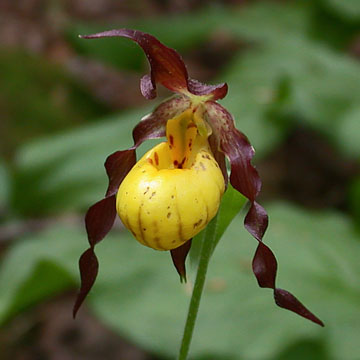

Cypripedium parviflorum - (image 1 of 7)
Taxonomy
Family: Orchidaceae
There are several recognized varieties of this species including var. pubescens (large flowered), var. parviflorum (small flowered, uppermost bract densely pubescent, southern) and var. makasin (small flowered, uppermost bract glabrous or sparsely pubescent, northern). Originally considered non-distinct from the European species C. calceolus L.
Habitat
Bogs, swamps, moist to wet woods. Slightly acid to neutral pH, sometimes on limestone. Plants in the north can be found in open areas.
Associates
Distribution
Circumboreal; south in North America to SC, LA, and NM.
Morphology
Perennial with pubescent stems and leaves; stem 20-80 cm. Leaves alternate, clasping/sheathing stem, oval to lance-ovate, 6-20 cm long, half as wide. Flowers 1-2, each subtended by an erect foliaceous bract; lip inflated, bright yellow, often purple-veined; lateral petals red-purple, long-lanceolate, usually twisted.
Notes
Flowers late May to June
Wetland indicator: FAC
This is one of the most widely distributed lady's slippers but by no means common; can be quite abundant where growing conditions are favorable. Reputed to be easier to grow in a garden setting than many other orchids, although it is best (and most ethical) to use greenhouse grown plants since transplanting can disrupt mycorrhizal associations; orchids transplanted from the wild often perish.
The plants pictured above are var. pubescens (Willd.) Knight which has a larger lip than the other two varieties (3-5.5 cm long vs. 1.5-3.5 cm long). Pictured below is var. makasin (Farw.) Sheviak which differs from var. parviflorum in that the lateral petals are evenly suffused with red-purple rather than densely dotted.

References
Gleason, Henry A.
and A. Cronquist. 1991. Manual of Vascular Plants of Northeastern United States
and Adjacent Canada. Second Ed.
The New York Botanical Garden. Bronx, NY
Swink, F. and G.
Wilhelm. 1994. Plants of the Chicago Region.
Indiana Academy of Science. The Morton Arboretum. Lisle, Illinois.
|
Michael Hough © 2009 |